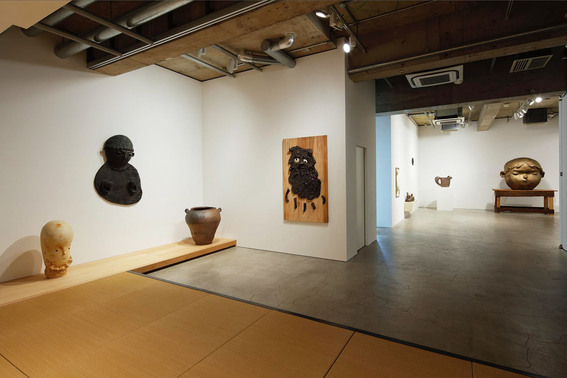-
From Current Issue
-
- Editor’s Letter Fire in the Heart
- Reviews I Gusti Ayu Kadek Murniasih
- Reviews 11th Seoul Mediacity Biennale: “One Escape at a Time”
- Dispatch Networked China
- One on One Monira Al Qadiri on Yukio Mishima
- Essays The rise of independent art spaces in pandemic-era Shanghai
- Features Tuan Andrew Nguyen
- Table of Contents
- Web Exclusives
- Archive
- Subscribe

R
E
V N
E
X
T
Installation view of OTANI WORKSHOP’s “When I was seventeen I learned about Giacometti from my art teacher and become drawn to sculpture—and so I make sculpture now” at Kaikai Kiki Gallery, Tokyo, 2016. Courtesy Kaikai Kiki Gallery.
When I Was Seventeen, I Learned About Giacometti From My Art Teacher and Became Drawn to Sculpture—and So I Make Sculptures Now.
Otani Workshop
Over the past few years, Otani Workshop (Shigeru Otani) has become increasingly recognized overseas as one of Japan’s more inquisitive and inventive sculptors, exhibiting alongside Kazunori Hamana and Yuji Ueda in Los Angeles in 2015 and New York earlier this year under the curatorial eye of fellow artist, gallerist and collector Takashi Murakami.
Otani’s latest exhibition is at Murakami’s Kaikai Kiki Gallery in Tokyo, “When I Was Seventeen, I Learned About Giacometti From My Art Teacher and Became Drawn to Sculpture—and So I Make Sculptures Now.” The show takes on a more introspective look at the impulse behind Otani’s work, giving the strong impression that he’s asking the question, “Who am I, and what is it that I do?” The answer comes filled with just as many questions, but they are more universal than might be imagined. A former assistant to Japanese artist Yoshitomo Nara, Otani’s original choice of an artist-name over his own certainly adds an element of detached responsibility to his practice, but whereas this might suggest a lack of commitment, it has in fact forced a greater self-awareness of his own production that his real name would only mask.
Born in Shiga prefecture just east of Kyoto, Otani assumed the name Otani Workshop soon after graduating Okinawa Prefectural University of Arts in 2004 and now lives in the town of Shigaraki. However, Otani had recently flirted with the idea of exhibiting purely as Shigeru Otani and it is this that strikes at the heart of his quandary—would a real name be taken as sign of serious commitment and therefore be taken more seriously by everyone else?
Challenged by Murakami himself to take just as much responsibility with his “professional” identity as his work, Otani stepped back to reflect on his days at art school, making sense of the expectation of being an artist and the limitations placed on craftsmanship. He recalled his love of Swiss sculptor Alberto Giacometti (1901–1966), whose interests was just as productive and whose influence can be clearly felt in the rough facial expressions that fill most of Otani’s work.
A Sitting Dog (all works 2016), Omiku, and Gold-colored Child are three pieces in this exhibition that describe Otani’s skill in working across different materials, from ceramics and bronzed glazing to plaster and wood. The loftiest piece in the show is the Untitled figure that stands at the far end of the gallery. A giant head hangs from the wall atop of outstretched legs, all of which have been formed in situ, and rendered in white unfinished clay with the weight of the head propped by two exposed timber battens.
Made from a distinctively earthy clay synonymous with Shiga, two pieces that stand out from the crowd of faces and figures in the exhibition are relatively traditional. An unfinished jug, Large Pitcher, rests in one corner, while Large Jar with Handles sits in the tatami room to the side, carrying with it odd leaves and Ginko seeds as remnants from the outdoors. Functional and practical as much as decorative, they are living breathing objects when seen alongside the sleeping faces on most of what is displayed.
The difference between art and craft is fluid in Japanese culture, which has a resolute disregard for any distinction between the two. Otani involves as much intuition as he does skill and technique, and is clearly comfortable veering off in other directions with materials be it wood or iron. In this sense, his work is just as sculptural as it is functional, be it a pitcher, jar, or jug, whether they rest on a cardboard box, sit on a packing crate or are placed an impromptu trolley. When asked what makes good pottery, fellow ceramic artist Teppei Ono replied, “Good pottery—it’s something without genre, used regardless of the material its made with,” an explanation that shows contemporary Japanese ceramic art as neither art nor craft, but a combination of both.
Equating material for daily life with the perceived world surrounding it, Japanese ceramics has gone from being a product of tradition and patience to an alternative culture of resistance and individuality. It comes at a time when the cultural norm in Japan is busy being homogenized with everywhere else. In their own subtle way, objects resist expectation and take on their own, playful and impractical meaning. And objects like the adorable yellow figure with piercing white eyes, A Beast, and the disturbing David, part man, part beast, and part teacup, resist being anything but themselves, all now shown under the very resolute umbrella of Otani Workshop.
Otani Workshop’s “When I was seventeen I learned about Giacometti from my art teacher and become drawn to sculpture—and so I make sculpture now” is on view at Kaikai Kiki Gallery, Tokyo, until December 24th, 2016.
To read more of ArtAsiaPacific’s articles, visit our Digital Library.








